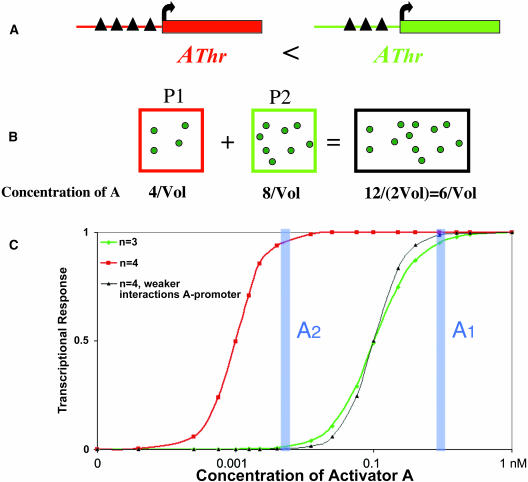Figure 3.
Potential Impact of Allopolyploidization or Hybridization on Transcription.
(A) Effect of an allopolyploidization event involving the two parental cells P1 and P2 on transcription from homologous promoters responding to the transactivator A. The black triangles represent the binding sites for A.
(B) In the simplest case, the parental cells have similar volumes (Vol) and similar DNA contents but might contain different amounts of A and promoters with different thresholds (AThr). After the merger, let us suppose that the volume doubles and that the regulation of the expression of A is unaltered. It is easy to see that, in this particular case, the expected concentration of A is intermediate. For instance, this concentration can be suitable to trigger expression from the promoter coming from P1 but not from P2.
(C) Transcriptional responses from promoters with three or four binding sites allowing cooperative interactions with the transactivator A. The solid curves are redrawn from Figure 5 of Veitia (2003b), with the same parameters. Decreasing the number of similar binding sites (n) shifts the position of the threshold to higher concentrations of A. In the case of a newly formed allopolyploid, if the resulting concentration of A is higher than the thresholds of both types of promoters (case A1), transcription is expected from both. If, on the contrary, the concentration of A is not high enough (i.e., A2), the red promoter will be on, while the green one will be off. Of course, cases of incomplete silencing are expected depending on the actual A concentration with respect to AThr. The thin black sigmoid represents a promoter with four binding sites that produces a response similar to that with three binding sites. It can be shown that there is an infinity of ways to obtain such a result, simply by changing the strength of the interaction between A and its binding sites, as long as cooperativity is maintained. This can explain the outcome of compensatory mutations.

